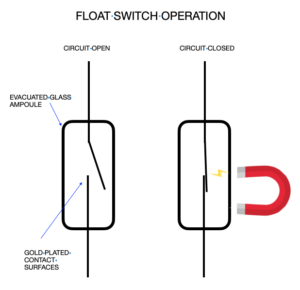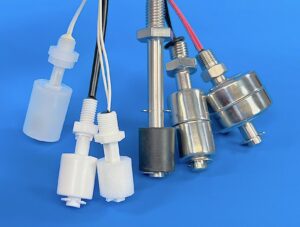
HOW FLOAT SWITCHES WORK
Float switches work by switching reed switch located inside the stem part of the float switch. When a magnet in the floating cylinder comes into the right position, the magnetic field causes the reed switch to change state. Typically the contact surfaces are sealed in a glass ampoule. Because the switch contact surfaces are in a vacuum, oxidation is eliminated and they are expected to last for millions of cycles.
CHOOSING A FLOAT SWITCH
To choose a float switch, the material of the floating cylinder must of course be compatible with the chemistry. (chemical compatibility chart here) After this, the secondary considerations are the size, cost, durability, and current capacity.
SMALL OR LARGE FORMAT? Large vertical float switches have the advantage that there is more physical space and more buoyancy to allow heavier-duty reed switches in order to handle higher current carrying capacity. This is needed if you are running AC current through the switch to directly control a device. This is common with sump pumps. However, running current through the switch shortens the life of the reed switch, which will lead to switch failure. Alternatively, in an electronic circuit passing just a few micro-amps the switch contact is expected to last for millions of contacts. Consequently, there is no advantage of a large format float switch when used “electronically”. (compared with electrically).
OUR MINIATURE FLOAT SWITCHES
Most of the vertical float switches we offer are miniature, or subminiature float switches. Although there is no official definition of what constitutes a “miniature” float switch, it makes sense that “miniature” should be reserved for the smallest possible version of product available. By this definition, a polypropylene float switch with a diameter of less than 18 mm would reasonably be called a miniature or subminiature float switch. For stainless steel, that size would be less than 23 mm diameter.

(Its amazing that many manufacturers call a 1.5 inch diameter plastic float “miniature”!) Miniature float switches have the advantage that they can fit in small openings like a 3/4″ drum bung. Also, they can be conveniently surrounded by a float guard to protect them from physical damage. If the switches are protected from chemical attack, electrical failure, and physical damage, what’s to stop them for lasting almost forever? That’s why we like miniature switches!
FLOAT SWITCHES FOR AQUEOUS LIQUIDS
In general, polypropylene floats are great for aqueous chemicals, including strong acids and caustic chemicals. The smallest float switch made (of any material) measures just 16 mm diameter. It has a very light specific gravity of just 0.5. This float switch is made from foamed polypropylene and we call our ‘P’ float.
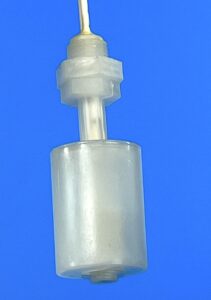
The disadvantage of this ‘P’ float switch is that it is not reversible, and it is a foamed construction which is does not repel some chemicals as well as molded polypropylene.
So for these applications we have another polypropylene float called our ‘F’ style. It is slightly larger diameter of 17.5 mm. In addition, it is a hollow molded part and therefore has a quite slippery surface with rounded edges, which is better at repelling liquids.
It also has the advantage that is is reversible. The specific gravity is 0.85 which is suitable for aqueous chemcials although not for some hydrocarbons which are lighter than 0.85.
Both of these polypropylene float switches are low cost and are the first choice if they are compatible with the chemistry in question. Link to float switch specifications here.
In addition to the polypropylene float switches, there is a PVDF (or Kynar®) float switch available. We call this our “K” float. This fluorinated plastic float is suitable for very aggressive chemicals and high temperatures. It is also small enough in diameter to fit in small drum bungs, and small enough to accommodate a float guard.
FLOAT SWITCHES FOR HYDROCARBONS
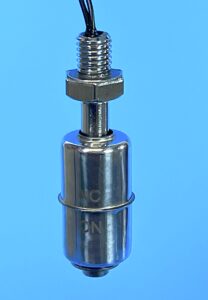
Choosing the a float switch for hydrocarbon chemicals usually comes down to stainless steel or BUNA, although our light-weight polypropylene ‘P’ style has been used successfully if the chemistry is right.
BUNA vertical float switches go by many names such as Nitrile rubber, NBR rubber, BUNA-N, acrylonitrile-butadiene and others.
The floating BUNA cylinder is actually a hard crystalline material that doesn’t seem at all like “rubber”, but is named so because it is derived from the same chemical reaction as rubbers. It is compatible with most aliphatic hydrocarbons, and many other chemicals. However it is difficult to classify broad categories of compatible chemicals so the chemical compatibility must be checked.
Stainless steel vertical float switches consist of a hollow cylinder. Our choice is 316 stainless steel for maximum corrosion resistance. Also, we prefer the narrow style which is 23mm in diameter. This way the floats can be equipped with a float guard, or fit into the ¾ inch bung of a steel drum. The specific gravity of this float is 0.73 – suitable for most hydrocarbons.
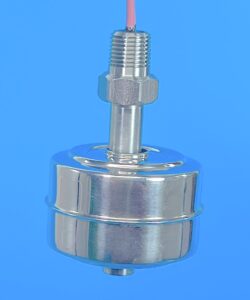
For very light density hydrocarbons we also carry a larger diameter 316 stainless steel float switch with a density of just 0.50. However, it is necessarily larger in diameter in order to achieve the lighter weight. This float we call our “U” float. (for ultralight) The diameter is 38mm. Specifications on all of the above float switches can be found on this page.

